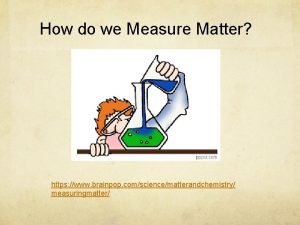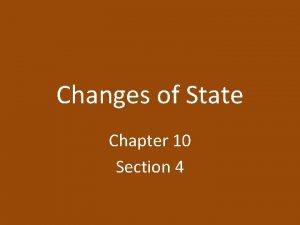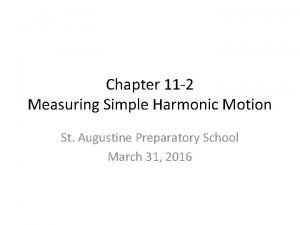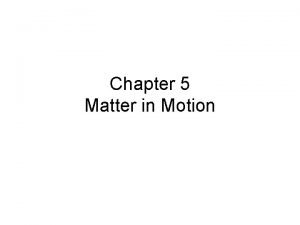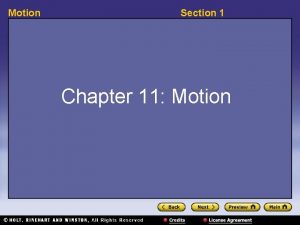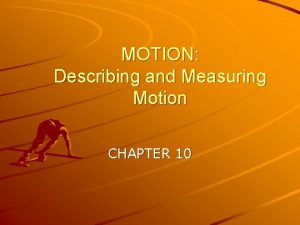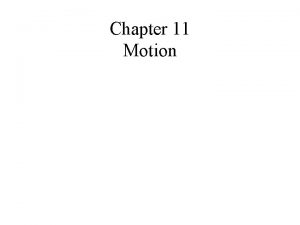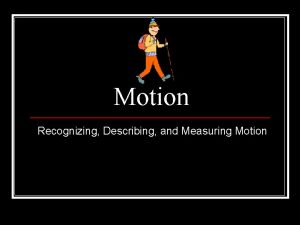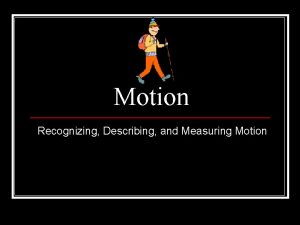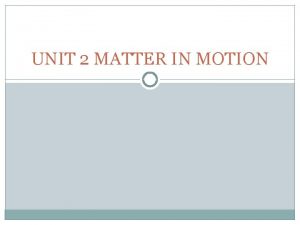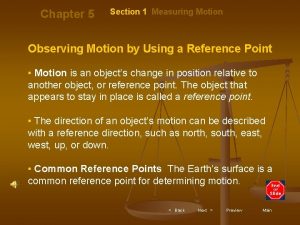Chapter 5 Matter in Motion Section 1 Measuring

















- Slides: 17

Chapter 5: Matter in Motion Section 1: Measuring Motion

Observing Motion • Motion is observed when an object appears to change position relative to a reference point (frame of reference). • The earth is the most common reference point. • When an object changes position over time relative to a reference point, as you see in figure 1 page 118, the object is in motion.

Speed: Distance and Time • Speed is the distance traveled by an object divided by the time taken to travel that distance. • The SI unit for speed is meters per second (m/s). Other common units for speed are kilometers per second (km/s), feet per second (ft/s), and miles per hour (mi/h).

Average Speed • Most of the time, objects do not move at a constant speed. • Average speed is calculated using the following formula: Average speed = total distance total time • The formula for distance is speed • time. • The formula for time is distance/speed.

Speed on a Graph • Speed can be represented on a distance-time graph. Time is on the x-axis, distance is on the yaxis. • The slope of the line on a distance-time graph for speed represents the rate of speed. • The steeper the slope, the greater the rate of speed. • If the line is straight, the speed is zero. • Draw a simple distance-time graph for the following: high rate of speed, low rate of speed, and a speed of zero.

Figure 2, page 119: This figure shows a graph of the speed of a car over a four hour period. • How far did the car actually travel in 2 hours? • 200 km • How far did the car travel in 4 hours? • 360 km • What was the average speed of the car? • 90 km/h • Try the practice problems in the Math Focus sections of page 120.

Velocity • Velocity is the speed of an object in a given direction. • An example of velocity would be an airplane traveling 600 km/h south. • An object’s velocity is constant only if its speed and direction are constant. • Constant velocity is always motion along a straight line.

Representing Velocity & Finding Resultant Velocity • Velocity is represented using an arrow. The point of the arrow shows the direction. The length of the arrow shows how much. • Combining velocities of objects will determine resultant velocity. • When combining velocities in the same direction, add them together. • When combining velocities in opposite directions, subtract the smaller velocity from the larger velocity. The direction is the same as the larger.

Figure 4 page 121 • Figure 4 shows a person walking along the aisle of a bus while the bus is in motion. • The resultant velocity of the person in the first illustration is 16 m/s east. • The resultant velocity of the person in the second illustration is 14 m/s east. • Why are these two velocities different?

Acceleration • Acceleration is the rate at which velocity changes over time. • Remember: velocity involves both speed and direction. • An object accelerates if either speed or direction change. • The faster the velocity changes the greater the accleration.

Types of Acceleration • Acceleration is commonly associated with an increase in speed, but an object accelerates if it slows down as well. (refer to the definition of acceleration) • An increase in velocity is called positive acceleration. (This is the same as speeding up in the positive direction or slowing down in the negative direction. ) • A decrease in velocity is called negative acceleration. (This is the same as slowing down in the positive direction or speeding up in the negative direction. )

Velocity-Time Graph

Velocity-Time Graph

Calculating Acceleration • Acceleration is found by using the following formula: A = final velocity – initial velocity time • Try the Math Practice question on page 122.

Graphing Acceleration • On a distance-time graph, acceleration is represented using a curved line.

Other Information Re. Acceleration • Some common units for acceleration are meters per second (m/s/s or m/s 2) or kilometers per hour per second (km/h/s). • Using algebra, rewrite the formula for acceleration to solve for final velocity. – vf = at + vi

Circular Motion • With circular motion, only the direction is changing, not the speed. • Centripetal acceleration is the acceleration that occurs in circular motion and is directed toward the center of the circular path.
 Chapter 11 section 1 measuring motion answer key
Chapter 11 section 1 measuring motion answer key Chapter 1 lesson 1 position and motion answer key
Chapter 1 lesson 1 position and motion answer key Chapter 2 section 1 classifying matter answer key
Chapter 2 section 1 classifying matter answer key Chapter 2 section 1 describing motion answer key
Chapter 2 section 1 describing motion answer key Measuring motion
Measuring motion Section 1 describing motion answer key
Section 1 describing motion answer key Classification of matter section 1 composition of matter
Classification of matter section 1 composition of matter Composition of matter section 1
Composition of matter section 1 Section 1 composition of matter chapter 15 answer key
Section 1 composition of matter chapter 15 answer key Section 1 describing motion
Section 1 describing motion The mole measuring matter
The mole measuring matter Why is mass more useful than weight for measuring matter
Why is mass more useful than weight for measuring matter The mole measuring matter
The mole measuring matter Measuring matter lab
Measuring matter lab How do you measure matter
How do you measure matter Chapter 10 review states of matter section 4
Chapter 10 review states of matter section 4 Chapter 2 principles of ecology answer key
Chapter 2 principles of ecology answer key The body of a 1275 kg car is supported
The body of a 1275 kg car is supported














